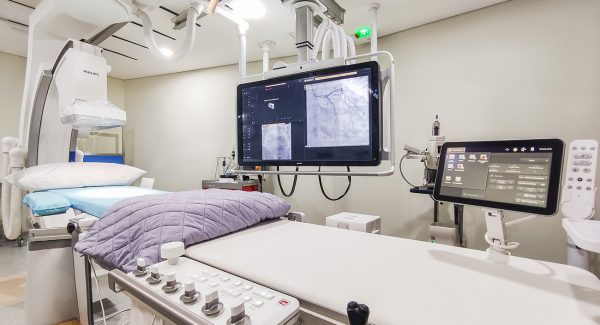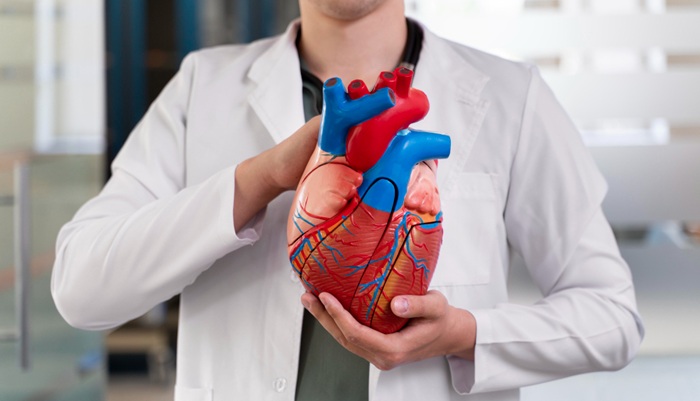Cardiac catheterization is a medical procedure used to diagnose and treat various heart and blood vessel conditions, such as arterial blockages or irregular heart rhythms. This procedure involves inserting a thin, flexible tube (catheter) through a blood vessel and guiding it to the heart.
Through cardiac catheterization, doctors can obtain vital information about heart muscle function, heart valves, and blood flow in the coronary arteries. During the procedure, doctors may also open narrowed arteries, measure pressures inside the heart, or even take tissue samples for further examination.
Mandaya Royal Hospital Puri is equipped with an advanced cardiac catheterization laboratory (Cath Lab) featuring cutting-edge technology for both diagnosis and treatment of heart conditions.
Contents
What Is the Purpose of Cardiac Catheterization?
Cardiac catheterization is a common medical procedure used to help identify and treat various heart problems. Conditions that can be diagnosed or treated with this procedure include:
- Coronary artery disease
- Congenital heart disease
- Heart failure
- Heart valve disease
- Damage to small blood vessels in the heart
Doctors typically recommend cardiac catheterization if a patient exhibits symptoms of heart disease, such as:
- Irregular heart rhythms (arrhythmia)
- Chest pain (angina)
- Shortness of breath during physical activity
During the procedure, doctors may perform several important actions, including:
- Checking for narrowing or blockages in the coronary arteries that may cause chest pain
- Measuring blood pressure and oxygen levels in different parts of the heart
- Assessing how well the heart pumps blood
- Collecting heart tissue samples for microscopic examination
- Detecting blood clots in the coronary vessels
In some cases, cardiac catheterization may be performed alongside other heart procedures or surgeries as part of a comprehensive treatment plan.
How Is Cardiac Catheterization Performed?
During the procedure, an IV line is placed in the patient’s arm or hand to administer sedatives that help them relax or become drowsy.
Patients typically remain awake during the procedure, though the level of sedation may vary depending on the purpose of the catheterization and the patient’s overall health. Some patients are fully awake, lightly sedated, or completely asleep depending on medical needs.
To perform cardiac catheterization, the doctor inserts one or more catheters into a blood vessel—usually in the groin or wrist—and guides them toward the heart using imaging assistance.
The next steps depend on the specific purpose of the procedure. Common types of cardiac catheterization include:
1. Coronary Angiogram
Used to detect blockages in the coronary arteries that supply blood to the heart. A special contrast dye is injected through the catheter, and X-ray imaging is used to visualize the arteries in detail.
2. Cardiac Ablation
Cardiac ablation uses heat or cold energy to create tiny scars in heart tissue to block abnormal electrical signals that cause arrhythmias (irregular heartbeats).
3. Right Heart Catheterization
The catheter is inserted through a vein in the neck or groin and equipped with sensors to measure pressure and blood flow in the right side of the heart.
4. Balloon Angioplasty (with or without Stent)
This procedure opens narrowed coronary arteries. A small balloon at the catheter’s tip is inflated to widen the artery. In many cases, a stent (a tiny mesh tube) is placed to keep the artery open.
5. Balloon Valvuloplasty
Used to widen a narrowed heart valve using a balloon-tipped catheter. The insertion site depends on the affected valve.
6. Heart Valve Replacement
Through a catheter, the doctor can remove a narrowed heart valve and replace it with an artificial one. One common method is Transcatheter Aortic Valve Replacement (TAVR).
7. Repair of Congenital Heart Defects
Catheterization can also be used to close holes in the heart, such as Atrial Septal Defect (ASD) or Patent Foramen Ovale (PFO).
8. Heart Biopsy
In this procedure, a catheter with a tiny “jaw-like” tip is used to collect a small heart tissue sample, which is then examined under a microscope in a laboratory.
Thanks to its diagnostic and therapeutic versatility, cardiac catheterization plays an essential role in detecting and treating heart diseases accurately and minimally invasively.
Mandaya Royal Hospital Puri’s Advanced Cardiac Catheterization Laboratory

Mandaya Royal Hospital Puri features a state-of-the-art cardiac catheterization laboratory designed to support a wide range of heart procedures with precision, safety, and speed. This facility serves as a center of excellence for cardiac diagnostics and interventions such as stent placement, cardiac ablation, and pacemaker implantation.
1. Advanced and Integrated Technology
The Cath Lab is equipped with modern fluoroscopy machines that provide real-time imaging of the heart and blood vessels during procedures. It is also integrated with IVUS (Intravascular Ultrasound) and iFR (Instantaneous Wave-Free Ratio)—two advanced systems that allow doctors to assess coronary artery conditions with high precision without additional invasive measures.
This integration enables detailed visualization of blood vessels, accurate assessment of arterial narrowing, and precise stent sizing. As a result, procedures become more efficient, accurate, and safe for patients.
2. Comprehensive Facilities and Readiness
Mandaya Royal Hospital Puri maintains a complete stock of stents (heart rings) in various sizes, ready for immediate use whenever required. This ensures that catheterization or stent placement procedures can be performed promptly, allowing patients to receive optimal treatment without delay.
In addition to the main operating room, the Cath Lab is equipped with a real-time monitoring room that tracks heart rhythm, blood pressure, and vital signs throughout the procedure.
3. Supporting Various Cardiac Conditions
With advanced technology and expert medical professionals, Mandaya Royal Hospital Puri’s Cath Lab can manage a wide range of cardiac conditions, including:
- Coronary artery blockages or narrowing
- Heart rhythm disorders (bradycardia or tachycardia)
- Pacemaker implantation needs
- Major vascular disorders (aortic conditions) requiring endovascular treatment
For a seamless visit to Mandaya Royal Hospital Puri, use the WhatsApp Chat, Book Appointment, or Care Dokter app—available on Google Play and App Store—to schedule visits, check queue numbers, and access complete hospital information easily.



